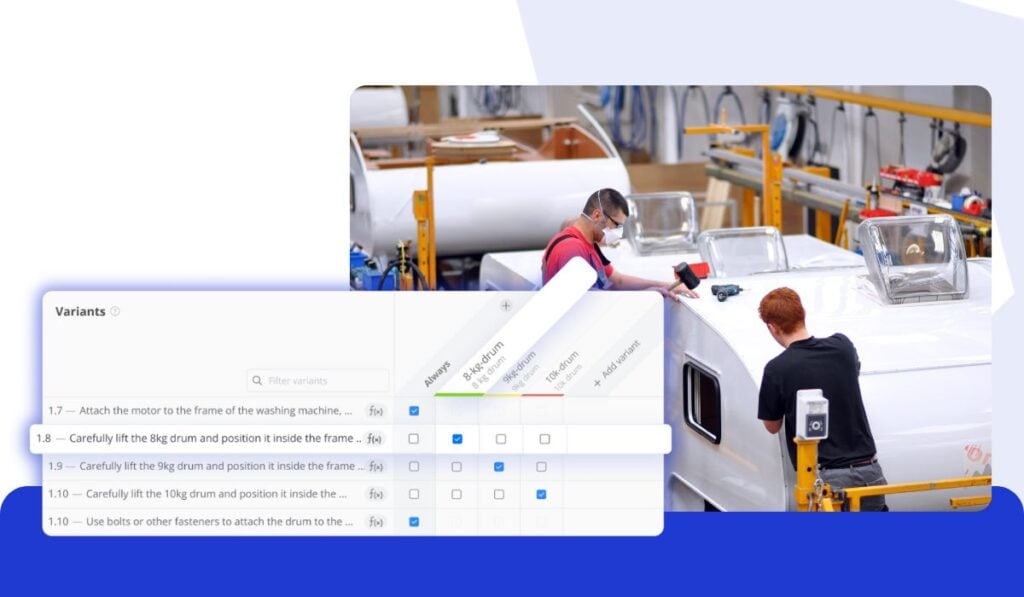We discovered some valuable ideas and strategies when creating our Azumuta Work Instruction Software. In this article, we will walk you through our ten-step process for building your own user manual.
Quick FAQs to get you up to speed
A user manual is a step-by-step guide that helps users operate a product, machine, or process correctly and efficiently.
It leads to confusion, training delays, production errors, and an increase in support requests.
- Define your audience – Understand the user’s skill level and needs.
- Outline key information – Identify the most important instructions.
- Use clear, simple language – Avoid jargon and technical complexity.
- Break down steps logically – Ensure a smooth flow of instructions.
- Add visuals – Use images, diagrams, and videos for clarity.
- Format for readability – Use headings, bullet points, and white space.
- Make it searchable – Organize content so users can find information fast.
- Test with real users – Get feedback and refine the manual.
- Go digital – Use digital tools for easy access and updates.
- Keep it up to date – Continuously improve and revise instructions.
Yes. Clear user manuals help meet industry regulations, safety standards (OSHA, ISO 9001), and product certification requirements.
Without them, workers make more mistakes, training takes longer, and production quality suffers—leading to increased costs and inefficiencies.
- Write with the end-user in mind—keep it simple and practical.
- Use multimedia elements to enhance clarity.
- Digitize manuals for real-time updates and easy access.
- Test it with actual users before finalizing.
✨ Azumuta Intelligence: Save Time Leveraging AI to Create Digital Work Instructions
See how user-friendly Azumuta Intelligence truly is
1. Identify Your target audience
First, you need to understand who your target audience is. Where do they read the instructions manual? What level of education do they have?
Before you start working on the user guide, it’s easier to create a persona. This way you know what you need to take into account.
Identifying your target audience can help you decide what type of material to include in the user manual, how detailed it should be, and how the information should be presented.
2. Define the Problem
To find the purpose of your instruction manual, start with the following elements:
- Explain the problem you are trying to solve
- Clarify the solution
- Describe the steps you took to get to the solution
Break down a difficult problem into small steps when you’re working on it. Make those stages brief and to-the-point so the problem can be fixed easily and quickly.
3. Be Specific
Leave out vague words and write exactly what you are talking about. When you speak of “this thing”, “this piece”, or “that part”, no one will understand what you mean.
If you can’t identify the term, look it up on the internet or ask a colleague. Because completing a step may require several keywords, no one will understand you if you say “this thing.”
4. Add Structure
Inserting a template will give structure to your user manual. A fixed style of pictures, bullet points and comments will give a clear overview. This will make the instructions easy to understand. Fortunately, you don’t have to go looking for a SOP or work instructions template because Azumuta has already created one for you.
Download Your Free Manual in Creating Paperless Work Instructions & SOPs
5. Use Pictures and Videos
A picture is worth a thousand words. Let’s be honest, a continuous text is not appealing to anyone. Inserting a photo or video into the instructions manual not only makes them more inviting, it also makes them easier to understand.
Nowadays, if you want to take a photo or video of your instructions, you don’t need expensive equipment. Just grab your smartphone and get to work!
6. Don’t Write in the First Person
When creating a user manual, it is best to write in the second person. This provides more clarity for the people who will need your user guide. For example when you write an instruction you don’t say “I pressed the green button”. But you say, “Next, you press the green button”. So try to create a clear and attractive user guide.
7. Use an Active Voice
Avoid using passive sentences because these can come across as vague. Instead let the reader know what to do. Use verbs to convey exactly what needs to be done.
8. Make it Simple
Give a quick overview of the instructions manual at the start, including what it is about, who will benefit from it, and what you can accomplish with it. A user manual is purely informative. Use short and clear sentences, because if people don’t comprehend what you’re talking about, they won’t use your manual.
9. Check for Accuracy
Make sure the user guide is correct and all the information is up to date. There is no room for mistakes. It’s critical that your instructions describe the procedures to be followed and explain how the devices and machines work.
10. Double Check your Manual
When you’ve finished writing your instructions manual, double-check everything. Did you use the correct terminology, did you follow the steps correctly, and is the manual written clearly for the reader?

Learn how manufacturers work smarter with Azumuta
Do you want a simple way to apply all of these tips and strategies to your business? We provide a free demo where you can see how to effectively use an instruction manual template. Discover Azumuta’s various features, including this one!
Use Azumuta’s Platform
See how our platform can help streamline data collection, increase productivity, and increase quality assurance with a demo of Azumuta.




